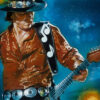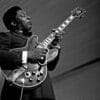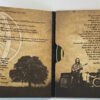African American slaves shaped jazz and blues through their musical traditions and spirituals. They infused both genres with their experiences and cultural heritage.
African American slaves laid the groundwork for jazz and blues music, drawing on deep-rooted cultural expressions and rhythmic innovations born from their history and life in the antebellum South. Cultivating a rich oral tradition, these individuals transformed hardship and suffering into powerful musical forms.
Work songs, field hollers, and spirituals became the soulful foundation of blues, while early jazz emerged from a fusion of African rhythms, European harmonies, and the improvisational spirit typifying the African-American experience. This cultural blend, a testament to resilience and creativity in the face of oppression, gave rise to genres that would not only shape American music but also become influential worldwide. These genres stand as enduring legacies of their profound impact on music history, mirroring the complexity and triumph of the human spirit.
African Musical Traditions
The roots of Jazz and Blues music intertwine deeply with African musical traditions. Slaves brought their musical heritage to the Americas, significantly shaping these music genres. Their influence lies in rich, complex elements carried across the ocean.
Drumming And Rhythms
African drums served as the heartbeat of many traditional ceremonies. Slaves recreated these rhythms using available materials, laying the foundation for modern beats in Jazz and Blues. The influence is clear in the syncopated rhythms and percussive sounds we hear today.
Call And Response
This musical conversation is a staple of African cultures. One person calls, another responds. It became a way for slaves to communicate and maintain connections. The pattern underpins Jazz improvisation and Blues lyrics, showcasing the intense emotional dialogue between musicians.
Work Songs And Field Hollers
The rhythms of work songs and field hollers helped coordinate labor. They were a tool for surviving the harshness of slave life. Their melodies and structures echoed in the soulful tunes of Blues. The repetition and steady cadences are evident in the heart-wrenching ballads of early Blues songs.
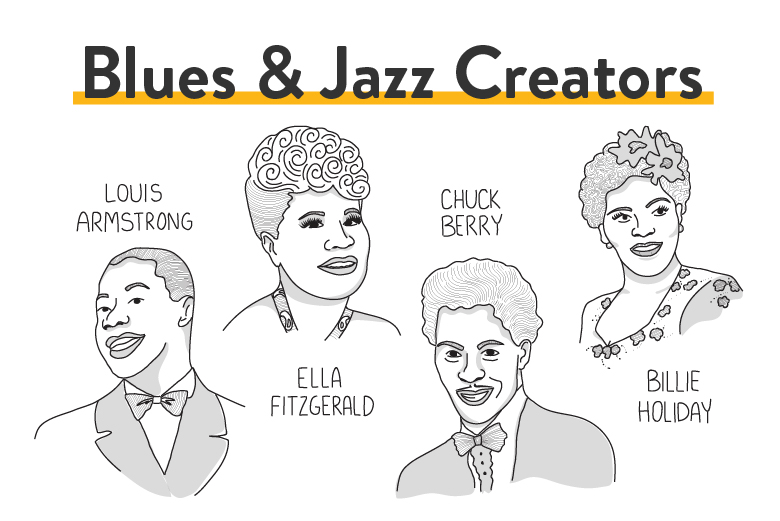
Credit: www.hoffmanacademy.com
The Influence Of Spirituals And Gospel Music
In the heart of the African American experience, spirituals and gospel music stand as cornerstones that shaped the iconic genres of jazz and blues. These musical forms, deeply embedded with emotional intensity and rich cultural heritage, offer a window into the resilience and creativity of slaves. Let’s delve into how these soul-stirring sounds influenced modern music.
Characteristics Of Spirituals
Spirituals stem from the profound depths of African American slavery. Featuring call-and-response patterns, spirituals provided a sense of unity and solace. They were coded messages of hope and liberation. Here are their key traits:
- Simple, repetitive melodies that are easy to remember and share
- Emotional lyrics that reflect the sorrow and hope of slaves
- Rhythmic intensity that echoes African musical heritage
- Improvisation, allowing for personal expression within the communal setting
The Role Of Gospel Music
Gospel music, with its profound spiritual expression, evolved from spirituals after slavery. It maintained the tradition of storytelling and emotional conveyance. Gospel music became a foundation for community strength in churches. Musicians honed their skills here before stepping onto the wider stage of jazz and blues. Attributes of gospel music include:
- Pentecostal fervor
- The energetic delivery and spiritual passion found in worship services
- Complex vocal harmony
- Multiple voices blending to enhance the emotional impact
Impact On Jazz And Blues
Jazz and blues, while distinct, both drew heavily from the richness of spirituals and gospel music. Influences from these historical sounds resonate through jazz’s improvisation and blues’ soulful narratives. This lineage is evident in several ways:
- The emotional depth of blues lyrics mirrors the poignant stories told in spirituals.
- Jazz’s dynamic rhythms and freedom of structure find their roots in the improvisational aspects of spirituals.
- Gospel music’s rich harmonies paved the way for the complex chords and arrangements in jazz.
- The expressive vocal techniques of gospel singers influenced jazz and blues vocalists.
These genres continue to evolve, forever carrying the legacy of their African American forbearers who used music as a form of resistance, communication, and hope.
The Role Of African Instruments
African American slaves brought more than just their strength to the New World; they brought their music too. This music, imbued with the soul of African rhythms and melodies, would evolve to become two of America’s most profound musical genres: jazz and blues. Central to this evolution was the use of African instruments, which provided the unique sounds that became the backbone of these genres.
Banjo
The banjo is one of the most iconic instruments in American folk music. It has its origins in African string instruments, which were made from hollowed-out gourds and wooden frames. African American slaves crafted their own versions, using whatever materials they had at hand, and it became a staple in early blues music, adding a distinctive twang that could convey both joy and sorrow.
Gourd Banjo
The gourd banjo, a direct descendant of African banjos, was an early form that featured a gourd body and a fretless neck. This simple design produced a resonant and rhythmic sound, perfect for the call-and-response style songs that would feed into the development of blues music.
Thumb Piano
Also known as the mbira or kalimba, the thumb piano is another African instrument that influenced American music. Its metallic tines plucked by the thumbs, produced a melodic percussive sound that can be heard in the background of early jazz and blues recordings. Its harmonies and rhythms made their way into the music of descendants of slaves, adding layers of emotional depth and complexity.
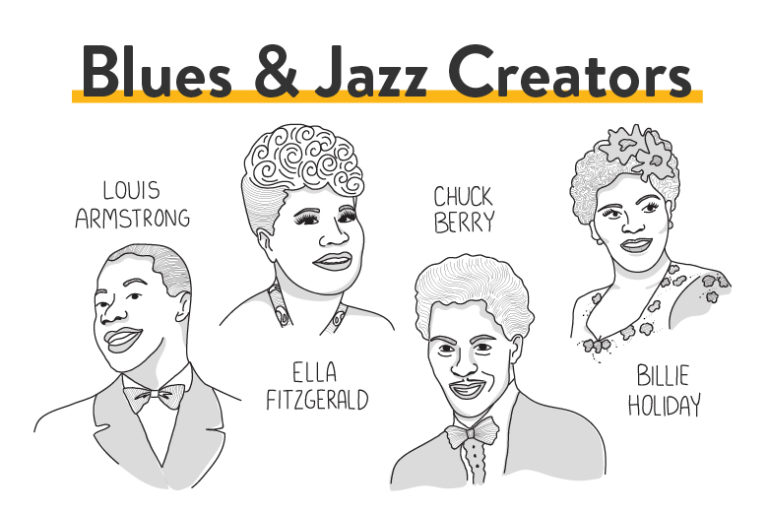
Credit: www.hoffmanacademy.com
The Migration And Cultural Exchange
Let’s explore how African American slaves shaped a new future for music. They brought their rhythms and songs to America. This created jazz and blues. It’s a story of movement and art mixing together.
The Great Migration
In the early 20th century, a big change happened. Many African Americans moved. They went from southern farms to northern cities. We call this The Great Migration. Why did this happen? Jobs and freedom pulled them north.
- Fleeing hardship – They wanted to escape the tough life in the south.
- Searching for work – The north had more jobs in industries.
- Creating communities – They built new homes and shared their culture.
Blues In The North
Blues music found a new voice in the north. African Americans brought their songs of struggle. It mixed with city sounds. This created a fresh, powerful blues style.
| Element | Influence on Blues |
|---|---|
| Rhythm | Beats got faster, echoing the pace of city life. |
| Themes | Songs talked about love, work, and freedom. |
| Instruments | Guitars and harmonicas met pianos and horns. |
Jazz In The Usa And Europe
Jazz spread its wings wide. From the USA to Europe, it soared. People everywhere fell in love with its energy. Jazz became a sign of modern life.
- New Orleans – Where jazz music was born.
- Chicago and New York – Where jazz grew up and found fame.
- Paris and London – Where jazz charmed a new audience.
Jazz bands and swing rhythms got everyone dancing. This music told stories. They were stories of hope and joy, born from pain.
Improvisation And Syncopation
The stories of African American slaves are deeply woven into the fabric of jazz and blues music. Two elements stand out: improvisation and syncopation. These musical features became crucial to the development of both genres, allowing for an expressive and dynamic sound. Let’s explore how they influenced jazz and blues.
Influencing Jazz
Jazz music owes much to the improvisational skills of African American musicians.
- Slaves often sang as they worked, creating songs on the spot. This shaped jazz’s improvisational nature.
- Improvised melodies allowed for personal expression within the music.
- Syncopated rhythms, where the emphasis is on off-beats, gave jazz its unique swing.
Jazz became a platform for innovators, where each performance was unique and alive with emotion. African rhythms, reimagined by slaves, added to its richness.
Influencing Blues
Blues music, with its deep emotional roots, was heavily influenced by the life experiences of slaves. Improvisation and syncopation played key roles here too.
- Field hollers and work songs, with their call-and-response patterns, became the blues’ backbone.
- The blues scale allowed for expressive bends and twists, highlighting improvisation.
- Syncopation in blues added a soulful, gritty edge to the music we recognize today.
African American slaves left a lasting imprint on music, using improvisation and syncopation to share their stories and shape new art forms.
Credit: www.si.edu
Prominent African American Musicians
The roots of jazz and blues are deeply entwined with the experiences of African American slaves. Their musical legacy brought forth a rich array of talent. Let’s celebrate a few key pioneers who left an indelible mark on music history.
Scott Joplin
Scott Joplin, often hailed as the “King of Ragtime,” brought syncopation to life. His compositions bridged classical and jazz worlds, influencing the entire genre. Songs like “The Entertainer” resonate with vibrancy and skill.
Louis Armstrong
Louis Armstrong’s trumpet sang with a voice all its own. His impact on jazz is immeasurable. “Satchmo” introduced inventive improvisation. His performances, recordings, and charisma shaped the sound of New Orleans and beyond.
Bessie Smith
The “Empress of the Blues,” Bessie Smith, poured her soul into every note. Her powerful voice echoed the hardships and triumphs of a generation. Bessie’s raw emotion and potent storytelling captivated listeners and stirred their hearts.
The Impact Of African American Slavery On Lyrics
Exploring ‘The Impact of African American Slavery on Lyrics’ reveals how the painful legacy of slavery shaped the very foundation of jazz and blues music. African American slaves crafted songs that conveyed profound emotions and experiences, leaving a lasting influence on these musical genres. Lyrics borne from slavery and its aftermath speak volumes about the cultural and emotional journeys that have been immortalized in jazz and blues.
Themes Of Struggle And Resilience
The lyrics of jazz and blues music are often saturated with the themes of struggle and resilience. They reflect the hardships faced by African American slaves and their determination to endure.
- Endless toil under oppressive conditions
- Longing for freedom and justice
- Perseverance in the face of insurmountable odds
Expressing Personal Experience
Personal tales of sorrow and joy gave jazz and blues a voice that echoes individual truths. Slaves used lyrics as an outlet for personal expression.
- Stories of loss and separation from loved ones
- Accounts of spiritual journeys and existential reflections
- Expressions of hope and aspiration amidst despair
Social Commentary
Jazz and blues lyrics often serve as a form of social commentary, reflecting on the injustices of the slave era and beyond. This lyrical content:
| Spotlights Injustice | Challenges Status Quo | Advocates for Change |
|---|---|---|
| Brings to light the harsh realities of slave life | Questions the societal norms of the time | Encourages listeners to strive for a better future |
Civil Rights Movement And Musical Activism
The Civil Rights Movement was not just a fight for equality in the courts and schools. African American music, especially jazz and blues, became a powerful tool for social change. Musicians used their art to stand against oppression. Jazz and blues helped spread the message of the movement far and wide.
Music As A Form Of Protest
The struggle for civil liberties found a voice in the rhythm of jazz and the soul of blues. African American slaves’ musical legacy turned into a form of resistance. Songs with coded messages once helped slaves escape. Now, these songs voiced a demand for freedom and equality.
- Celebrating African American culture
- Conveying messages of hope and resilience
- Highlighting issues of racial injustice
Promoting Equality And Justice
Jazz and blues artists painted a picture of a world where all are equal. They sang about the dream of justice. Each note and word in their music served as a plea for a society free of prejudice.
- Stories told through music reached many
- Lyrics questioned and condemned segregation
- Melodies inspired unity and strength
Artists As Activists
Many jazz and blues musicians became leaders, using their fame to fight against racial inequality. They did not just play music. They stood on the front lines for civil rights.
| Artist | Contribution |
|---|---|
| Nina Simone | Songs like “Mississippi Goddam” expressed anger and called for change |
| Louis Armstrong | Spoke out against segregation |
| Billie Holiday | Sang “Strange Fruit,” a haunting protest against lynching |
These artists and their music remind us that every voice has the power to make a difference.
Legacies Of African American Slavery In Jazz And Blues
The profound impact of African American slaves on jazz and blues cannot be overstated. Their experiences, expressed through music, have forged a powerful cultural legacy. These genres are steeped in the history and resilience of a people who used song as a form of resistance and communication. They crafted a new language in music that laid the foundation for modern jazz and blues.
Global Influence
Jazz and blues crossed oceans, affecting music around the globe. Their rhythms and melodies influenced many genres. Rock, hip-hop, and samba are just a few.
- Rock ‘n’ Roll: Blues provided its soul, while jazz contributed improvisation skills.
- Hip-Hop: Known for sampling, these genres are vital sources.
- World Music: African rhythms form jazz and blues resonate worldwide.
Continued Evolution
Today, jazz and blues remain dynamic, ever-evolving genres interacting with new musical styles and technologies.
| Element | Influence in Evolution |
|---|---|
| Technology | Electronic instruments and software have changed how these genres are produced and experienced. |
| Musical Fusion | Jazz and blues merge with other styles, creating exciting new subgenres. |
| Social Messages | Artists use these platforms to advocate for change, just as their ancestors did. |
Preserving Cultural Heritage
Museums and cultural institutions dedicate themselves to preserving the history of jazz and blues.
- Exhibits showcase the instruments, original scores, and attire of prominent jazz and blues artists.
- Educational programs teach new generations about the significance of these genres.
- Live performances and festivals celebrate the legacy and continually renew interest in jazz and blues.
Frequently Asked Questions On How Did African American Slaves Influence Jazz And Blues Music
How Did American Slaves Influence Jazz?
American slaves blended African musical traditions with European influences to create the foundations of jazz. Their work songs, rhythms, and spirituals heavily contributed to jazz’s unique sound and improvisational style.
How Did Slavery Affect The Blues Music?
Slavery deeply influenced blues music, reflecting the struggle, pain, and resilience of enslaved African Americans through soulful rhythms and lyrical storytelling.
How Did African American Music Influence Jazz?
African American music, comprising blues and ragtime, birthed jazz by blending African rhythms, work songs, and spirituals, which evolved into a distinct, improvisational art form.
How Did Slaves Influence Music?
Slaves significantly shaped music by integrating African rhythms, melodies, and instruments into American culture. Their work songs, spirituals, and blues served as the foundation for genres like jazz, rock, and hip-hop.
How Did Slaves Create Jazz And Blues Music?
Slaves infused their African musical heritage with American cultural elements, leading to the creation of jazz and blues.
What Role Did Spirituals Play In Jazz Development?
Spirituals, originally sung by slaves, provided rhythmic and melodic foundations that were integral to early jazz.
How Did The Blues Express Slaves’ Life Experiences?
Blues music encapsulated the pain, struggle, and hope of slaves, reflecting their life experiences through soulful melodies.
Did Slave Songs Impact Jazz Instruments Usage?
Slave songs influenced the use of certain instruments like the banjo and drums, which became staples in jazz ensembles.
What Is The Historical Link Between Slavery And Blues?
The blues genre originated from African American slave songs and work chants, evolving as an expression of their suffering and resilience.
How Did Call-and-response Patterns Shape Jazz?
Call-and-response patterns from African traditions became a defining characteristic of jazz improvisation and interaction.
Conclusion
The deep roots of jazz and blues music can be traced back to the resilience and creativity of enslaved Africans in America. Their enduring spirit forged a legacy that reshaped the musical landscape. These genres, rich with emotional depth, reflect a history of struggle and triumph.
By honoring their influence, we keep a vital piece of cultural heritage alive.





